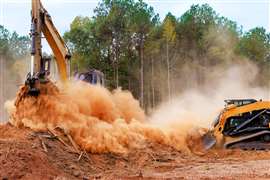Superior deploys big Demag
10 September 2020
Superior Cranes used a Demag CC 6800-1 for difficult petrochemical lifts in Virginia
Specialist contractor Superior Cranes in the USA put its recently purchased 1,250 tonne capacity Demag CC 6800-1 crawler crane to work on a challenging petrochemical job in Virginia.

“Prior to purchasing the 1,375 [US]-ton crane, we could not have completed the lift,” said Joe Everett, Superior Cranes president. “For that matter, few lifting companies east of the Mississippi River could.”
It was the first project Superior Cranes completed with the new crane. Demag engineers assisted in devising a lift plan for a site with limited access and crane mobility after the load was lifted. Vessels weighing 680,000 pounds (308 tonne) vessels had to be removed and replaced for the petrochemical company.
“The crane had to navigate on the narrow job site,” said Everett. “We had to build a pad for the crane, so the counterweight could swing over the top of the building. The lifts took nearly eight months to plan.”
The crane had to be positioned away from the 20 foot (6 metre) diameter, 40 foot (12 metre) tall vessels. The Superior Cranes crew then used a 300 ton (272 tonne) crawler assist crane to build out the CC 6800-1. Crew members installed 259 feet (78.9 metres) of main boom and 134.2 feet (41 metres) of superlift boom.
To help improve safety, especially when assembling and dismantling the CC 6800-1, it was fitted with the Demag Fall Protection system. “This system stops a fall prior to the worker reaching the ground, reducing the possibility of injury,” said Hans Hofer, Demag service engineer. “It is quickly installed from ground level and includes a vest harness equipped with a shock absorber.”
The lifts required 1,719,000 pounds (780 tonnes) of counterweight, distributed as follows: 551,000 pounds (250 tonnes) in the superstructure, 176,000 pounds (80 tonnes) of central ballast and 992,000 pounds (450 tonnes) on the superlift tray. The lifts were made at 125- and 136-feet (38 and 41 metre) radii due to site access limitations. A total of 12 picks were made in the month Superior Cranes was on site. Wedged between obstructions, the operator carefully kept the boom within lifting radius with the variable Superlift counterweight tray connected to the carbody. After the vessel was secured, the crane was boomed up and it positioned the load close to the carbody. Crews then disconnected the superlift tray to rotate the vessel and reposition it to its staging area.




